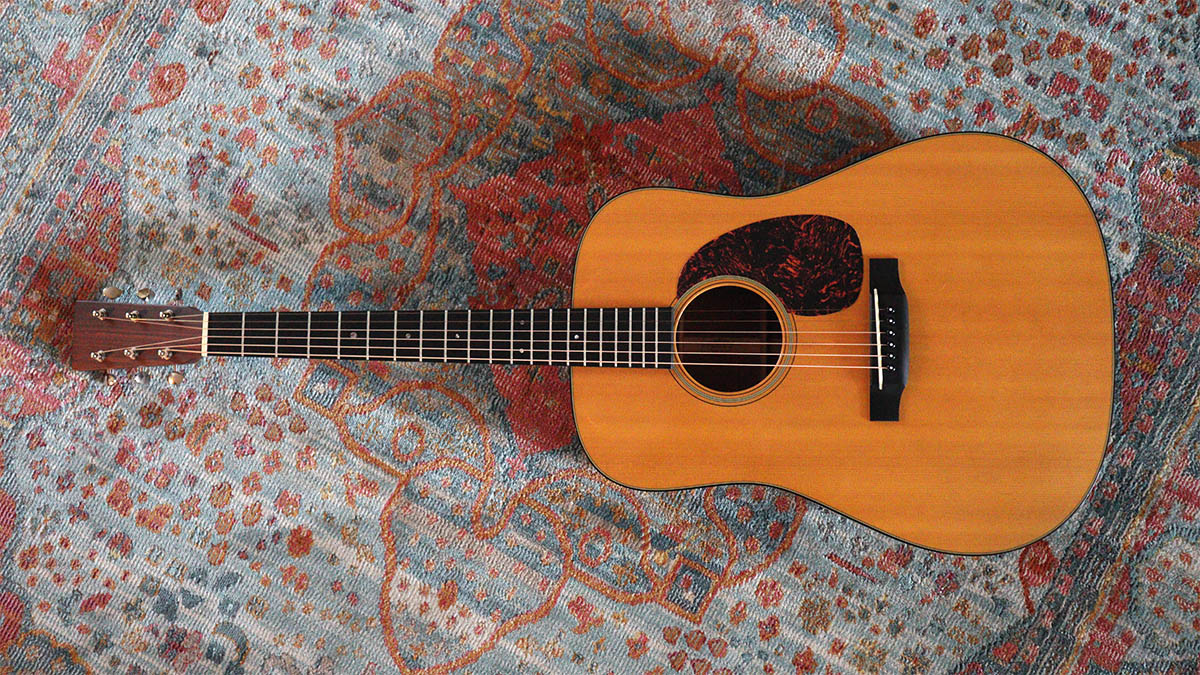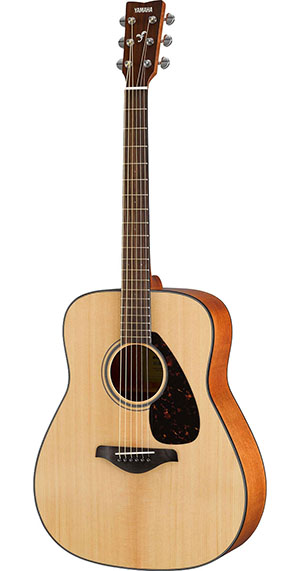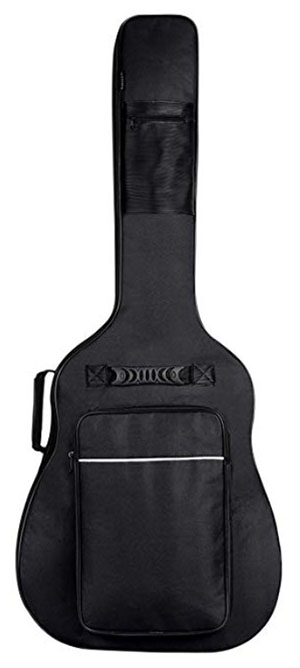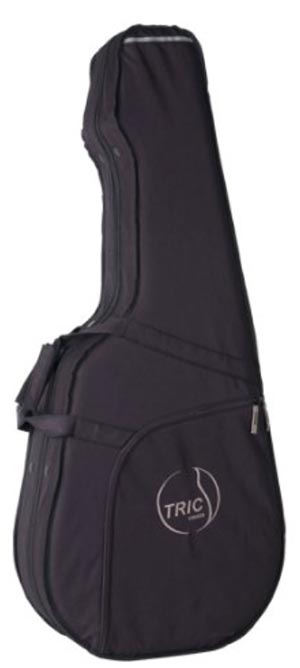I’ll cut right to it. If you’re looking for a great acoustic guitar to learn how to play, these are the two that I recommend. Both are great for players age 12 and up, and perfect for a teenager who doesn’t want a lame beginner guitar. (hint, the Fender CD-60S comes in some cool colors if that’s important to you). You really can’t go wrong with either of these, and they’re both under $200!
If you’re buying an acoustic guitar, you’re going to want to know how to change the strings. Check out my Visual Step-by-Step Guide to Changing Acoustic Guitar Strings.
Table of Contents
Fender CD-60s vs. Yamaha FG800
The Fender CD-60s is a standard dreadnought shaped acoustic guitar that sounds incredible for only $200. The “s” in CD-60s stands for solid top, and this one features a solid spruce top wood. The solid wood provides a rich, warm tone that doesn’t sound thin or cheap. Here are some other features of the Fender CD-60s.
- Beautiful natural gloss finish
- Solid spruce top
- Plied mahogany back and sides
- Rosewood fingerboard and bridge
- 1 year Fender warranty
Another great option is the Yamaha FG800 Acoustic. This is also a dreadnaught shape but has a little more bend in the waist making it easy for smaller players. This guitar features a quality solid spruce top and plied back and sides. One of my favorite features about the Yamaha acoustic guitars is the satin neck which makes sliding through different chords a breeze. Here are some other features of the Yamaha FG800.
- Natural finish with satin back, sides, and neck
- Solid Sitka spruce top wood
- Plied Nato back and sides
- Rosewood fingerboard and bridge
You’re going to want to pick up a case for your new acoustic guitar. You can go with a hardshell case, but these tend to be heavy and pricey. A gig bag, like the one shown above, provides adequate protection while being light, easy to carry, and relatively inexpensive. Check this one out.
Now for the Details: Guide to Buying a Beginner Guitar
Why Acoustic Guitar?
This is a common question among people looking to learn guitar. Should I get an electric guitar or and acoustic guitar? I emphatically recommend starting on acoustic! Sure, Enter Sandman sounds awesome on a distorted electric guitar, but that same sound will mask some important mistakes that you’re making.
The foundation of guitar playing is the tone produced between your fingers, the strings, and the fretboard. Learning on an acoustic guitar is the only way to built the finger strength and the tone necessary to progress your playing. Once you’ve learned these basics, transitioning to electric guitar is much easier. So you can easily go acoustic to electric, but going electric to acoustic can be pretty frustrating.
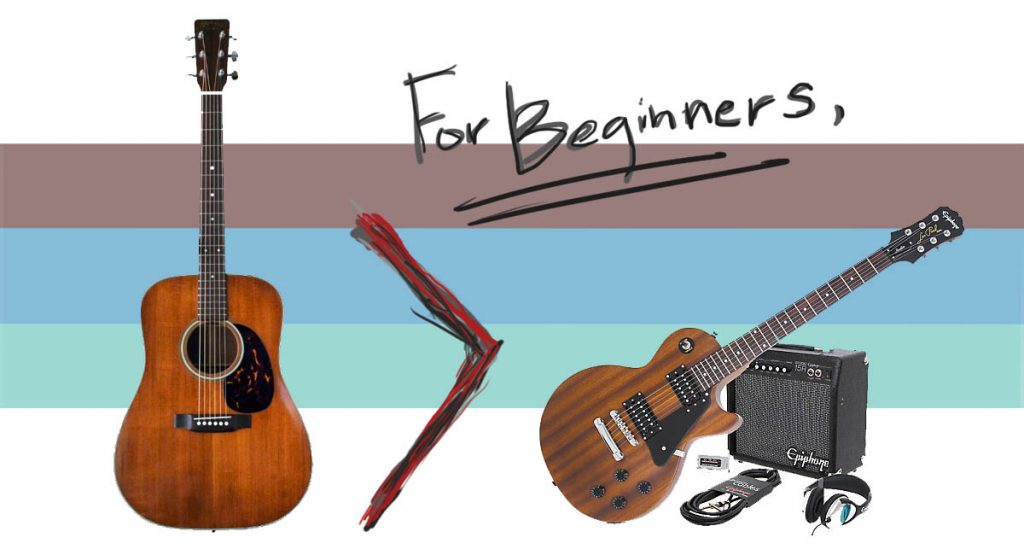
Once you get your acoustic guitar, picks, and tuner, you’re pretty much good to go. You can play anywhere, anytime. An electric guitar is tied to the wall by the number of feet the power cord is. I mean, sure you can get a long extension chord, but you look decidedly less cool carrying that thing around with you.

If you’re going the electric guitar route, then you also need to consider the added cost of buying an amp and instrument cable. This can easily add a couple hundred extra to the overall price tag, and while fun and exciting, certainly isn’t necessary to learn how to play. If you do go this route, check out the best beginner electric guitar amplifier I recommend.
Things To Look For When Buying a Guitar
Interested in a deep dive on Fender’s best guitars (both acoustic and electric) for beginners? Take a look at this!
Value vs. Quality
The single most important thing when looking for a first guitar is buying something that is of good quality and won’t stand in the way of you learning how to play. I’ve seen many “starter” guitars that are so poorly built that it would be impossible for someone to not give up entirely while trying to learn on it.
This is especially true if it’s a younger person who is having to wrestle with a poorly setup or poorly built guitar. You don’t want the guitar to get in the way of the learning.
This leaves us to find the middle ground between the amount of money we want to spend, and the quality of an instrument. While these two factors are closely related, they are not mutually exclusive. Affordable does not necessarily mean poor quality, and (possibly more importantly) expensive does not necessarily insure quality.
Through years of experience selling guitars, working on guitars, and teaching lessons I have found a couple great beginner guitars that satisfy both the need for value and offer a cool and effective instrument on which to learn.
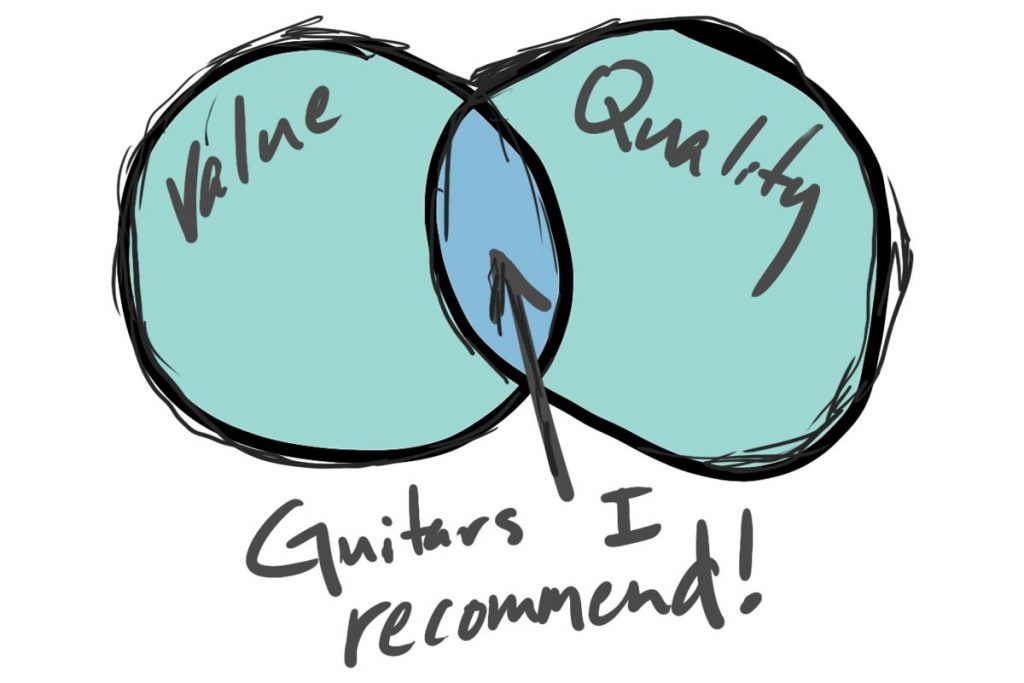
Playability
If you buy one of the guitars that I recommend, you will end up with a great playing guitar with smooth action. It will be an instrument that you will enjoy for many years to come.
Playability describes how easy a guitar is to play. More specifically, playability describes the quality of tone and feel as it relates to the playing of the guitar.
For example, if the strings are too far away from the fretboard, it’s going to be difficult to “fret” that note and the tone of that note is likely going to be unclear.
Additionally, too high of action (distance between strings and fretboard) may mean that the guitar’s intonation is off, resulting in out of tune notes even when the open string is tuned correctly.
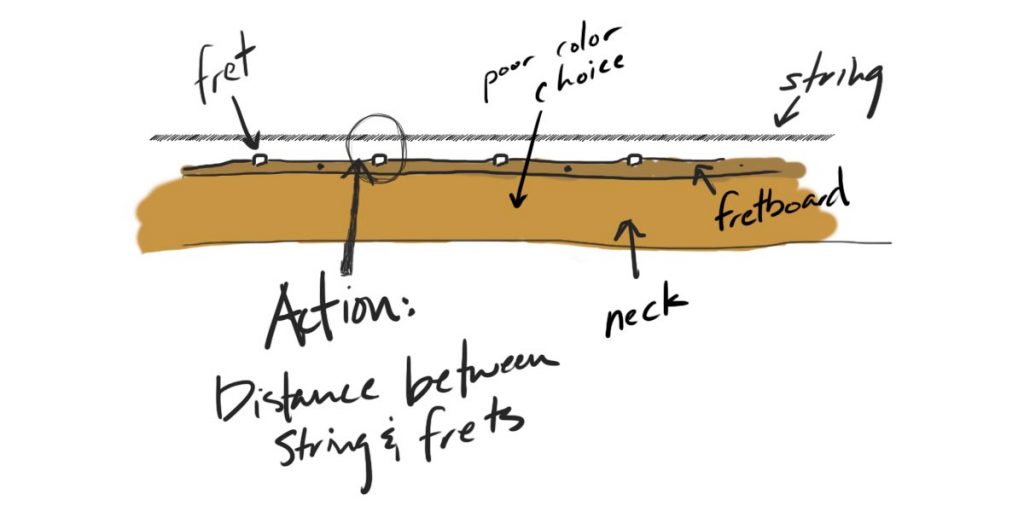
Unless you have been playing guitar for awhile, it is extremely difficult to know exactly what to look for in a guitar. This is why I always recommend buying a new guitar as opposed to a used one if you’re just starting out.
Learning to play is not always easy, and as a new player, you won’t know if it is the guitar that’s holding you back or if you just need to practice harder. I will address the pitfalls of used guitar in the section “What to avoid when buying a guitar” below, but in terms of what to look for, here are my main pointers:
Buy a new guitar
I know that I’m starting to sound like a broken record here, but the best thing that you can do at this point is buy a new guitar. There are too many subtle things to look for in a used guitar that can have a major impact on the playability.
If you don’t have the experience, don’t test your luck. Do you want to buy a $200 guitar that works great out of the box, and allows the beginner to be successful, or do you want to spend $100 on a used guitar that has so many issues it is impossible to actually play?
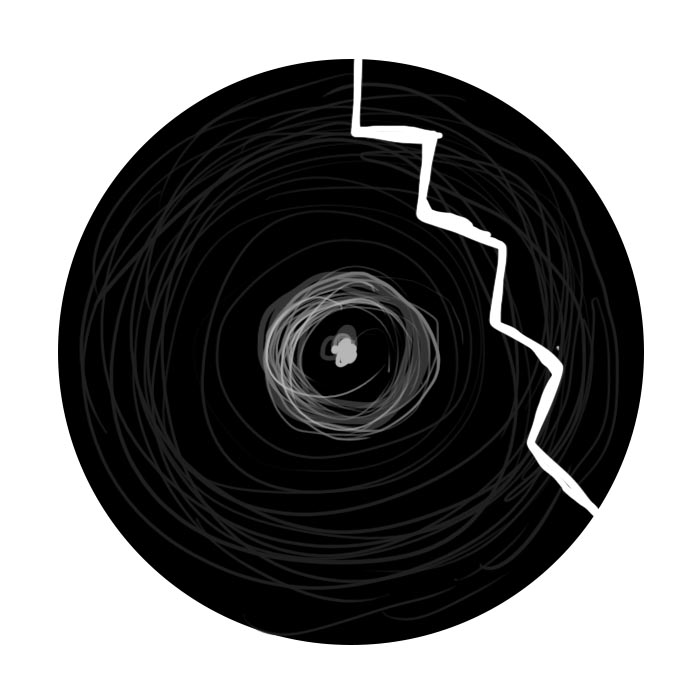
When I did guitar repair at a local guitar shop, the number of people who would buy used guitars on craigslist, ebay, or a pawn shop was staggering. They would always come in very proud of the great deal that they got, and were often bringing the guitar in to get a fresh set of strings put on.
It was always hard to see their reaction when I would walk them through the work that needed to be done in order to get the guitar in playing condition. After a $100 – $200 quote, they were usually a whole lot less enthusiastic about their purchase.
I’m not trying to rip anyone off, please do not buy a used guitar unless you know exactly what to look for. You will most likely end up spending much more in the end, or just having a nice looking dust collector in the corner.
Price Range at least $200
It is common to see starter guitars in the $100 to $150 range. What I have found is that these guitars a put together very cheaply and often have structural or setup issues from the factory.
Often times, wood quality goes down and causes issues with the frets and neck that can only be handled with expensive repair bills. I made this mistake when I learned how to play many years ago, and as a result had a bunch of ‘dead’ notes on the neck that wouldn’t even make any noise.
I consider the bottom of the usable range to be at $150. Going below this will get you a cheaply made guitar that will not be enjoyable to learn on. You may find that these guitars I have recommended may be on sale and less than $150. If that’s the case, go for it! These ranges are general indications of quality.
Buy a nice hardshell case or gig bag
Having a nice case for your acoustic guitar goes a long way to protect your investment. If the guitar is going to leave the house, which for most people it would, I don’t even consider not having a case an option.
The gig bag I recommend at the beginning of the article is a great, inexpensive option that provides a decent amount of support and protection, and is light which is great for younger players.
A hardshell case is typically a bit more expensive, but will protect the guitar better than anything else. The TRIC case is my favorite hardshell case for acoustic guitars because it is both incredibly light, and provides better protection than a standard wood hardshell case.
It is a little on the pricey end at just under $100, but is completely worth it. These are hardshell cases made of molded plastic and a dense styrofoam material that helps regulate temperature and humidity. These cases are light, and won’t damage easily like most other hardshell cases.
Shy away from packages
While packages are an attractive option, giving you everything you need to get started in one fell swoop, they often contain cheaper items that ultimately won’t work well in order to make up for lost margin. I recommend buying a guitar, and then buying the accessories separately.
This allows you flexibility in what you want to buy (get that dope Jimi Hendrix strap), and gets you higher overall quality. The biggest thing here is that you don’t want the package to include a lesser quality guitar to make up for the lower package cost. The guitar is the most important thing, focus on the accessories after.
If needed, have it setup by a local guitar tech
Now, if you follow my advice and buy one of these recommended guitars, more than likely it will be perfectly playable right out of the box. This is clearly our goal here, as we don’t want to spend any more time and money than necessary.
However, guitars are made of wood, and wood is a moving object. As humidity changes, a guitar’s materials can expand and contract. This can cause the guitar to go out of alignment and will then need a trip to the guitar tech’s bench. If you feel like the guitar isn’t quite right then take it in to your local guitar shop.
Almost every guitar shop is equipped with someone who can look at your guitar and give you a quote on a “setup”, if your guitar needs one. I find most local shops to be quite helpful, so don’t hesitate to bring it in!
Looking Cool
Is looking cool really important when buying a guitar!? Absolutely! I know that answer will make a lot of parents cringe, but from all of my experience it is completely true. The success of a beginner is defined by more than just hard work and persistence.
Yes, these things are the root of learning, but the overall experience is also defined by the instrument’s aesthetic, the type of music that is being learned, and the external pressures to succeed. This is especially true with younger players. So, if you’re looking for a guitar for a younger player, make sure that they think the guitar looks cool!
A natural finish might appeal to a parent’s sense of workmanship, but a black or tobacco burst finish may give that extra push that a teenager needs to be consistent in practicing.
Types of guitar finishes
While there are different types of material used for guitar finishes, the guitars in the 200 – 1000 dollar range will most likely be a polyurethane. The advantage of this type of finish is that it is very durable.
If the guitar gets bumped or knocked around a little bit, this harder finish will protect the underlying wood. More expensive finishes are lighter and allow the wood to resonate (vibrate) more which affects the overall sound. However, this is an advanced topic that should only be considered when someone has been playing for a couple of years.
Colors!
Guitar finishes also come in a myriad of colors. Natural or clear, black, and bursts are all common examples. Many can have a slight tint to them that is usually brown or complements the tone of of the wood. It doesn’t matter what color you choose, just make sure you like it! The color of a guitar has no effect on the sound or playability, so this one is all personal preference.
Accessorize
The look of the guitar isn’t the only thing that can make you look cool. Explore the awesome guitar straps from Levi’s to give the overall package a great look. I really like their strap styles, and are the closest thing that I can find to my vintage strap I use on my Strat. If you want that Woodstock ’69 look, look no further! Levi Straps on Amazon
What to Avoid When Buying a Guitar
Used
If you are buying a guitar used, you really need to know what to look for. For people who are buying a beginner guitar for themselves or as a gift for someone else, I strongly recommend avoiding used guitars all together.
In the price point that we’re talking about (<$250) you really won’t save that much money buying used, and the risks involved are too great. The last thing that I want any new guitar player to experience is frustration because the guitar they have isn’t providing a good learning experience.
Worst case scenario is you waste a bunch of money on something that never gets used. $200 spent in the right way will save you time, money, and headaches down the road. Please whatever you do, don’t buy a used guitar because it looks like a good deal.
Harder to see problems
The reason I harp on used guitars so much is that there are quite a few things to look at with a used guitar that you don’t have to deal with when you buy one that came straight from the factory.
- Neck Angle: Old guitars can start to have neck problems in relation to how they connect to the body of the guitar. Neck resetting is extremely expensive, and sometimes that is the only way to get a guitar with neck angle issues playable.
- Bridge Condition: People used to put very heavy strings onto an acoustic guitar in order to get more volume out of it. The side effect is that the bridge can sometimes lift off the guitar body if it’s put under too much tension. Above that, extensive damage can be caused to the bridge plate (spruce reinforcement under bridge) which requires major repair work.
- Humidity Issues: Guitars are made out of different types of wood, and different materials (binding, wood, metal, etc). All of these expand and contract at different rates as humidity in the air changes. If a guitar is not humidified correctly, cracks can develop which can turn into a much larger issue if they’re not repaired promptly. Sometimes these cracks are hard to spot, and often the guitar needs to be gone over with a fine toothed comb (and a mirror and shop light) in order to insure no cracking has started.
- Neck warping: Again, because it is a piece of wood, and wood moves with humidity, a neck can have issues not initially seen because the neck has been warped. With high tension from the guitar strings, a guitar that hasn’t been properly cared for will often develop neck issues.
- Fret Buzzing: Fret problems occur has frets wear or move around (usually due to humidity changes). High or low frets will cause buzzing that apart from being annoying will often wholly stop a guitar from being playable. Fret work can be very expensive depending on the extent of what needs to be done.
- Tuners: It is not uncommon to see tuner problems popping up in old, lesser quality tuners. Sometimes gearing is stripped out, sometimes they can loosen up which can make it impossible to keep the guitar in tune.
- Random buzzing, and other noises: Noises (other than the desired notes) can come from many places and things in a guitar. If you know where it is coming from you can get a sense for how hard it would be to fix. However, I have seen many used acoustics with loose bracing that is a much bigger fix than the owner wanted to deal with. Do yourself a favor and don’t buy a used guitar.
This is just a portion of the number of things that can go wrong with an acoustic guitar. Do yourself a solid and don’t buy a used guitar. Or if you are dead set on this route, take someone who knows about guitars to help determine if it’ll be a great instrument to learn on, or a hunk or dust collecting garbage better left out back for the raccoons. Hey, they need instruments too.
Higher priced guitars without solid tops
There are two main types of guitar tops on acoustics. Solid and Laminate. Now, solid top guitars are higher end, better quality, and will sound better overall. Laminate tops are generally less expensive, they hold up great to abuse and humidity changes, and the sound pretty decent overall.
How do you know if a guitar has a solid or laminate top? Check out this article where I discuss the difference between the two and how to tell.
While both of the guitars I recommend to start out on are solid top guitars, there are some great sounding laminate guitars that I think are an awesome option when just beginning. Moving up into a solid top guitar later is a great way to go as you won’t be able to tell the difference anyway when you’re just starting out.
One thing to look out for are higher priced guitars (>$300) that have laminate tops. There are a lot of companies that try to add other features like cutaways and electronics in order to charge more, while still putting a lower quality top on their guitars. Don’t fall for this ploy, and don’t buy a laminated top guitar if it is over $300.
Why the Fender CD-60S?
Fender has been around since 1946, and has been making quality gear ever since. I personally own Fender guitars and amps and love nearly everything that they produce. This guitar specifically is a perfect option for a beginner. They come set up perfectly from the factory, and sound great. In fact, when I taught lessons, this was my go-to recommendation for new students. At only $200 you can get into a solid spruce top guitar, and that is a great deal!
I also like the Fender because of the finishes come in Natural, Mahogany, Black, and Sunburst. Plenty of options to find just what you’re looking for.
Also can go with the “SCE” model which comes with a cutaway for access to the higher frets, and a built-in preamp and tuner. The cutaway isn’t at all necessary to learn guitar, and you probably won’t honestly use if for the first couple years of playing.
However, they do look pretty cool, and the electronics will allow you to plug the guitar into an amp if you want. Those come with a built in tuner, but I would shy away from that. Buying a quality clip-on tuner will work much better than the built in type.
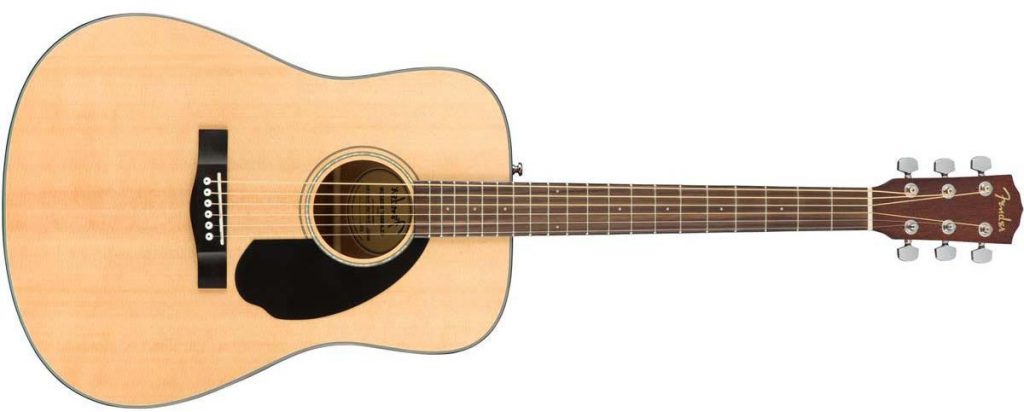
Why the Yamaha FG800?
Similar to Fender, Yamaha has been making quality instruments for a long time. If you’re looking for a guitar that will get you well on your way to learning how to play, then the Yamaha F800 may be the perfect choice. It boasts a solid spruce top with laminated back and sides very much like the Fender CD-60s.
One thing that I like about the Yamaha is that the back, sides, and neck are finished in a satin sheen instead of a high gloss. I like the way this looks, but also how it feels while holding it. The satin neck doesn’t get sticky like a glossy neck can when your hands are sweating a little bit. If your hands often are sweaty, then consider the Yamaha.
The Yamaha is a little more limited on colors, but the Natural and Ruby Red complement the instrument nicely.
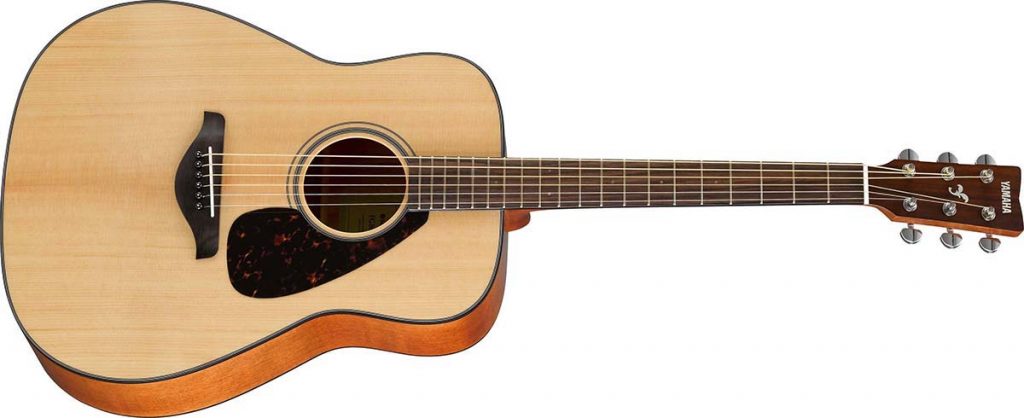
What Else Do You Need to Get Started?
Whew! I got the guitar now I’m good to go right!? For the most part yes! Get to playing. Stop reading this and get those callouses on the fingertips building! Here are other things that all guitar players need, so consider these accessories as well.
- Clip on tuner
- Picks
- Strap
- Capo
- Guitar Stand
- Polishing Cloth and Cleaner
- Extra Strings (How to change strings on an Acoustic Guitar)
- String winder
- Wire snips
